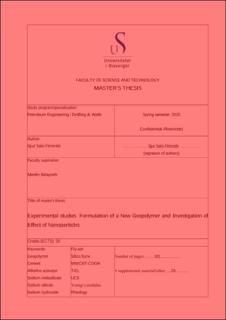| dc.description.abstract | Well integrity survey from the Norwegian Continental Shelf (NCS) indicated that out of the 75 production and injection wells, cement recorded about 11% integrity issue. According to the NORSOK D-10 requirement for cement properties, the conventional Portland cement does not fulfil all the criteria. Integrity issues associated with cement is also documented in other parts of the word. In recent years, there has been a high focus on searching a cost-effective and reliable alternative material to the Portland cement as a well barrier. The application of geopolymers is one of the best candidates that is attracting the oil and gas industry. However, the work is still under research and development phases.
In this thesis work, during the first phase of the project, with the considered screening and qualifying criteria, three new geopolymer mixtures were formulated and characterized. During the second phase of the research, the effect of titanium oxide (TiO2) and –COOH functionalized multi-walled-carbon-nanotube (MWCNT-COOH) on the neat geopolymers were investigated. Furthermore, the neat -and nanoparticle treated geopolymer were compared with Portland class G cement. The alkaline activator for the geopolymer consisted of 10M NaOH along with a home-made synthesized sodium metasilicate liquid made with different concentrations of (45.1%, milky color), (30%, clear color) and (45.1%, clear color). Moreover, a commercial sodium silicate solution was tested.
The application of the neat geopolymer to be utilized for construction and oil well cementing is based on the pumpability of the slurry and strength development. All the plugs cured at 62oC and room pressure. The slurries were mixed by hand, which comprised of a lot of air. Despite these worst-case conditions of the geopolymers formulated in this thesis work, the results obtained are interesting and satisfactory. However, by reducing the uncertainties associated with the geopolymer slurry mixing, the author feels that even more improved results can be achieved. Moreover, the effect of TiO2 and MWCNT-COOH nanoparticles solutions showed both positive and negative impacts on the mechanical and elastic properties of the neat geopolymers. The optimum and positive synergy of the nanoparticles with geopolymer were determined from the considered experimental condition. | en_US |

